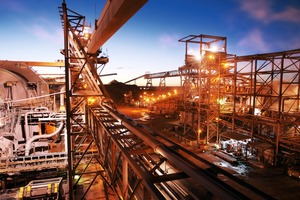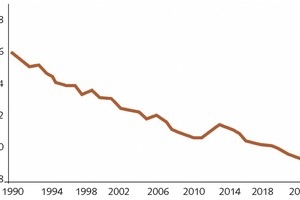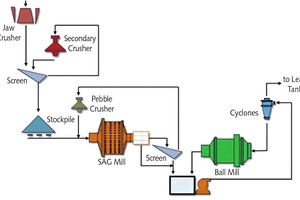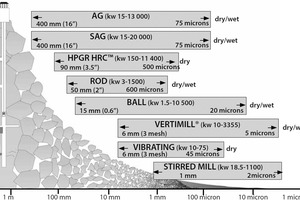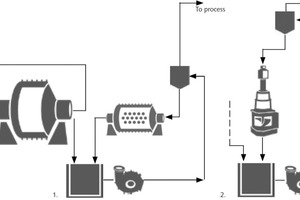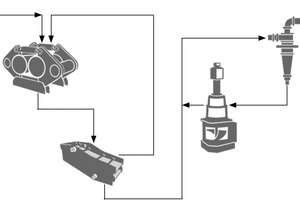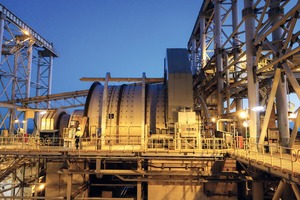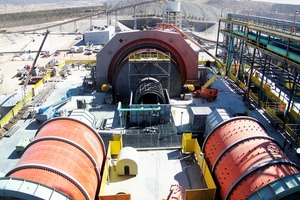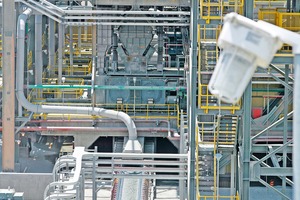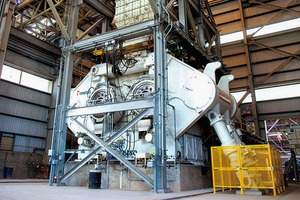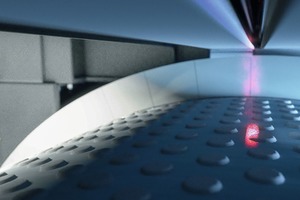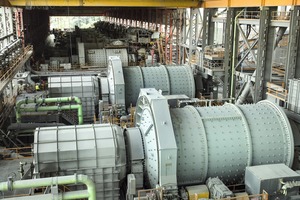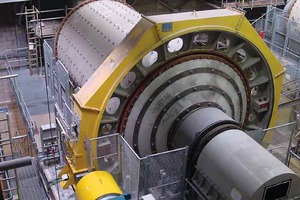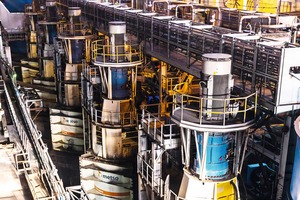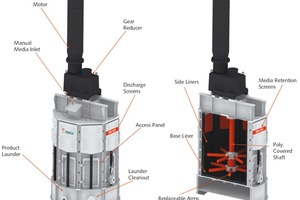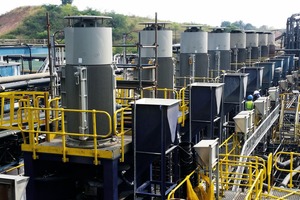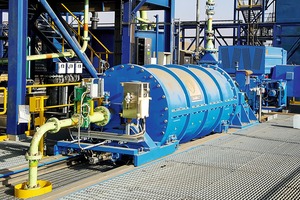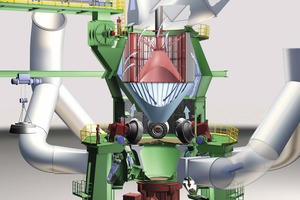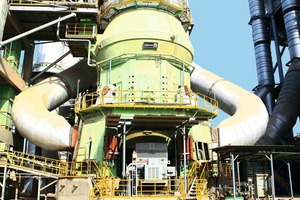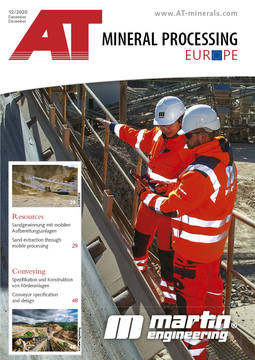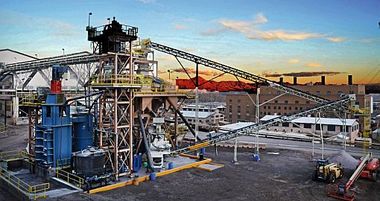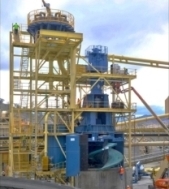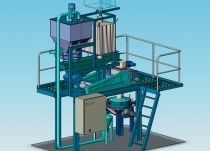Trends in the mining industry
Summary: The deteriorating quality of resources is becoming an increasing problem in mining. To compensate for the poorer qualities, the volumes of materials extracted are being increased, leading to exponential growing of the energy required, and a commensurate rise in processing costs. This all mounts up especially for the grinding processes, which play a key role in the extraction of metal resources. In the following paper, we present the challenges for modern grinding processes and their contribution to providing a solution.
1 Introduction
Ore deposits with high content of recoverables are becoming increasingly rare. For some ores, the decrease in metal content is so significant that grinding to particle sizes smaller than 80 micrometres (µm) and below is necessary to ensure sufficient liberation of the ore [1]. Fig. 1 shows an overview of the average copper content in the ore beneficiation plants worldwide; this has decreased by almost 0.7 % Cu/t ore to 0.9 % Cu/t ore since 1990. An average ore content of just 0.8 % Cu/t ore is forecast by 2030. As the leading nation in copper ore extraction, Chile is affected especially by this, as most mines there have already been exploited for years [2]. Table 1 shows how at BHP Billiton alone the copper ore content has decreased over the last year in two of its biggest mines in Chile and what impact this had had on its output rates.
The impact on the cash costs is considerable, as a survey commissioned by Cochilco, the Chilean copper commission, shows. In the cost analysis for the comparative period 1st quarter 2018 and 1st quarter 2019, an increase in the cash costs from 136.1 US$/lb (61.7 US$/kg) to 138.0 US$/lb (62.6 US$/kg) was calculated. The cost increase of 1.9 US$/lb (0.9 US$/kg) only accounts for an increase of 1.4 %, crucial, however, is the make-up of the costs (Table 2). The costs for acid consumption, other consumables and energy costs are rising disproportionately, while it has even been possible to save on costs in respect of services, wages and further processing of the concentrates. Falling copper ore content therefore has an impact on the costs for energy and consumables.
Lower ore content primarily demands a higher run-of-mine (ROM) in the mining operations, to obtain the same metal yields. This especially affects the volumes processed in the mill circuits. Another important influence emerges when finer grinding is required. Ultimately, decreasing ore content and the required level of grinding, which already today incur by far the largest energy consumption in ore beneficiation [3], are not only the crucial factor for the energy costs, but also for the consumption costs (mill wear, consumables for flotation and the heap leaching). The significance of the grinding process becomes clear from the fact that the maintenance requirement of a processing plant is primarily dictated and influenced by the maintenance requirement of the mills.
2 Focus on grinding technology
To comminute ores from particle sizes of several metres to the micrometre range, crushers and mills are combined with each other in several stages (Fig. 2). In every stage, only a relatively small degree of size reduction is possible. The size reduction ratio is the ratio of feed particle size to the final particle size on completion of the comminution stage. While only relatively small size reduction ratios of 3 – 10 can be achieved with conventional crushers, these can reach 1000 and more for certain types of mills. Fig. 3 shows the different types of mills with reference to their key application and the corresponding possible feed and product particle sizes [4]. Typical types of mill used in ore beneficiation are autogenous (AG) and semi-autogenous (SAG) mills together with ball mills to, for example, obtain particle sizes smaller than 100 µm.
One process variation that has become increasingly established in recent years is the combination of AG or SAG mill with a ball mill and a downstream agitated ball mill (Fig. 4). The second grinding circuit is effective especially in flotation plants to obtain the finenesses required for the flotation stages, which often necessitate regrinding to finenesses smaller than 30 µm. Instead of conventional AG/SAG and ball mills, processes only with high-pressure grinding rolls (HPGR) and vertical mills (Fig. 5) or other combinations of mill types are employed in practice. Besides a pure grinding feed, a crucial aspect is the optimum energy utilization in beneficiation for the respective types of ore and applications.
2.1 Developments in mill types
The range of different mill types and grinding processes has never been as wide as it is today. From the leading suppliers, practically all key types of mill are available today in various sizes for different capacity ranges. Although these mills have been introduced on the market for a long time, especially recent years have seen numerous new developments. The major international mill suppliers include FLSmidth, Metso Outotec (MO), thyssenkrupp and the Chinese firm CITIC.
2.2 AG and SAG mills
In the mining industry, AG mills and SAG mills are very much the workhorses when it comes to grinding technology. This is especially down to the fact that these types of mills can achieve the same size reduction ratio for the feed material as two or three other comminution stages put together. In addition, very high throughput rates up to 40 000 t/d can be achieved with large-sized mills (Fig. 6). Moreover, these mills can be designed for both wet and dry grinding. Up to now, SAG mills with diameters up to 12.8 m have been designed for copper ore, at which the mills have reached the limits of their capacity. If you look at the advances of the last few years, there have been no further leaps in development for these types of mill in respect of throughput rate, energy consumption, availability and wear.
For drive capacities of such mills to around 18 MW, mostly conventional (RMD) rim mill drives are used, for higher powers to 28 MW gearless mill drives (GMD) are used. The advantages of such GMD solutions compared with the RMD solution are multiplied with the mill size. The drum of the mill forms the rotor of the motor, while the motor poles are arranged at a very close distance around the outer circumference of the drum. The elimination of gears increases the efficiency and the availability of the mills and at the same time reduces the maintenance requirement. Moreover, these drives are suitable for speed control, which can significantly reduce the energy consumption for the grinding process.
SAG mills are experiencing a certain renaissance for new projects. Only at the start of the year, for example, FLSmidth landed a big order for a new copper ore beneficiation installation in Russia with two SAG mills and two downstream ball mills respectively (Fig. 7). These are SAG mills with 12.2 m diameter and 28 MW GMD drive and ball mills with 8.5 m diameter and 22 MW GMD drives. The first production line is set to go into operation in 2022. For existing SAG grinding systems, the Megaliner concept from Metso Outotec is also very interesting. In this, different mill linings like hard facing, poly-metals, rubber and ceramics are combined to achieve much higher throughput rates and longer service lifetimes of the wear elements. Thanks to the longer lifetimes, especially maintenance downtime of the mills is set to be drastically reduced.
2.3 HPGRs (High-Pressure Grinding Rolls)
Today, HPGRs are some of the most important types of mill in the mining industry. From the market leader thyssenkrupp alone, so far more than 130 roller crushers have been sold for a range of different applications, such as grinding diamond ore/kimberlite, iron ore or iron ore concentrate and metal ores (hard rock). The first notable application for copper ore came in 1995 at the Cyprus Sierrita copper mine in the USA. However, on account of the extremely abrasive ore, no economical service lifetimes could be achieved for the grinding rolls. The breakthrough came in 2006 at the Cerro Verde copper ore project (Fig. 8) in Peru. By 2014, a total of 12 HPGRs had been supplied there, completely replacing an SAG concept. The comparison with a conventional grinding circuit with SAGs and ball mills returns a 21 % lower energy demand and annual operating cost savings of almost 15 mill. US$ [5].
The applications for hard rock comprise besides copper ore, gold ore, ore in the platinum group metals (PGM), molybdenum ore as well as zinc/lead ore. A large share of the HPGRs introduced so far are used as tertiary crushers downstream of primary and secondary crushers. In many such cases, on account of the achieved fineness, an additional SAG mill is no longer required, and the crushed/ground ore can be fed to a ball mill for fine grinding. For copper and gold ore as the most important minerals, mostly closed circuits with wet grinding are used. There are generally hardly limits to the different options for switching and combination of the machines as HPGRs can also be used as the crushing stage in SAG circuits.
HPGRs for the mining industry are supplied not only by thyssenkrupp but also by FLSmidth, Metso Outotec, Weir Minerals and CITIC. The largest HPGR so far in existence in the world was put into operation by Metso for the Morenci copper mine owned by Freeport-McMoRan in the USA for a throughput rate of 5400 t/h copper ore (Fig. 9). The mill is equipped with a drive of 2 x 5700 kW. Mill development at all suppliers in the last few years has brought extreme advances in respect of operational reliability, improved lifetimes and maintenance friendliness. thyssenkrupp intends to raise the bar to the next level with the HPGR Pro. This machine boasts several new features (Fig. 10) and, compared to existing HPGRs, delivers a 20 % higher throughput rate, 15-%-lower energy consumption and a 30 % longer lifetime of the rolls.
2.4 Ball mills and other tube mills
Ball mills as well as rod mills are widely used in the mining industry on account of their simplicity. Ball mills in particular play an important role in secondary grinding of ores to final particle sizes smaller than 100 µm. The market leader Metso Outotec alone has delivered more than 8000 such mills for the mining industry (Fig. 11). While rod mills tend to cover the lower throughput range, ball mills are now supplied with diameters up to 9.1 m and 14 m length whereas a few years ago the diameter was still limited to 7.3 m. However, the efficiency of these mills is relatively low so that many mine operators are trying to replace these mills with more efficient processes as delivered by, for example, agitated ball mills.
The mills in the smaller diameter range are completely standardized with rotating drum, inlet and outlet, bearing and drive. At FLSmidth, tube mills are supplied in the range from 1.6 to 4.3 m diameter in the Fast Track Series (Fig. 12). The mills can be optionally operated as ball or rod mills for wet or dry grinding. The advantage is low-cost, standardized solutions, that enable a fast changeover from existing mills.
2.5 Agitated ball mills
2.5.1 Low-speed mills (tower mills)
Tower mills or vertimills (VTM) were introduced onto the market in Japan in the 1950s. Today, with Metso Outotec, thyssenkrupp, Eirich and CITIC, there are four mill suppliers that offer these low-speed agitated ball mills for ore beneficiation. In line with the grinding principle of these mills, a slow-speed screw in the mill chamber effects circulation of the suspension and grinding media against the force of gravity. This has proven effective for the comminution of ores with feed sizes up to 6 mm and final finenesses of 80 % smaller than 20 µm. Most mills are used for the regrinding of ore concentrates in a fineness range from 30 – 80 µm (Fig. 13). In this fineness range, the energy demand is 25 – 35 % lower than in conventional ball mills.
In recent years, tower mills have been used increasingly for secondary and tertiary grinding. This is possible thanks to larger machine concepts and consequently higher throughput rates. At Metso Outotec, with the VTM 3000 and VTM 4500, machine sizes with drive powers of 2240 kW and 3352 kW have been engineered. A VTM 6000 is currently under development. The larger machine sizes enable an around 50-% higher throughput rate and reduce the investment and operating costs per kW. Metso Outotec has recently received an order for an Australian gold mine at which two VTM 4500s are operated. Here the ore with feed sizes up to 6 mm is ground to finenesses of 30 µm. The plant is set to go into operation in 2021. These are the largest vertimills in Australia so far.
2.5.2 High-speed agitated ball mills
With regard to high-speed agitated ball mills, a differentiation is made between horizontal and vertical agitator mills. In the latter, the suspension is pumped through the mill chamber, which is filled with up to 70 % grinding media. The agitator consists of rods, discs or similar rotating at peripheral speeds up to 15 m/s (Fig. 14). Accordingly, the mill can be supplied with high working power. In the different models of the mill suppliers, the grinding media are retained by means of different separating devices like slotted screens, etc. The mills are currently used in over 90 % of cases for regrinding ore concentrates like copper, lead, zinc, molybdenum, PGM-, chromium- and gold ore. A few are used in tertiary grinding.
The most important suppliers of these mills for ore beneficiation are Metso Outotec with the SMD (Stirred Media Detritor) and HIG mill as well as FLSmidth with the VXP mill. The VXP is a further development of the Deswig mill. The mills are used mostly for the ultrafine grinding of ore concentrations. For Barrick Gold’s Kibala project, a total of eight VXPs were supplied (Fig. 15), the ores being ground by different satellite plants from 40 – 70 µm feed size to 15 – 20 µm final particle size. Market leader in this sector remains the SMD from Metso, of which around 200 mills are in operation, most for fine and ultrafine grinding in ore beneficiation. For Boliden Harjavalta, recently another mill was sold for the recovery of copper from copper slag.
There have already been extensive reports on the development of the IsaMillsTM [1; 2; 3]. So far, 150 of these horizontal agitated mills have been sold. The mills are completely closed, the suspension to be ground running through the mill quasi as piston flow. The grinding principle demands relatively high grinding disk peripheral speeds up to 20 m/s. This is combined with relatively densely packed inert grinding media in the size from 2 – 5 mm. Over 85 % of the applications so far concern ore beneficiation of platinum group metals, copper/gold ore as well as lead/zinc ore [6]. Fig. 16 shows an M10 000 IsaMillTM at Minsur’s San Rafael tin mine in Peru. The mill is used there for the B2 project for reprocessing tailings. Minsur is planning to produce around 51 000 t tin over a project duration of 9 years.
The so far largest size of the IsaMillTM is an M15 000 with a drive power of 3.7 MW. Such a machine is in operation at Teck Resources at its Red Dog zinc mine in North-western Alaska, 170 km north of the Polar circle. This is already the third IsaMillTM for this mine. The M15 000 has an inner volume of 15 m3, that is less than 1/10 of the volume of a ball mill, but boasts comparative power. Correspondingly, IsaMillsTM reach very high grinding intensity of 400 kW/m3, compared, for example, with ball mills that reach 20 kW/m3. The machine sizes of the IsaMillTM comprise the M500 as the smallest with 200 kW drive power up to the M50 000 with 8 MW. To complement the series of seven mill sizes so far, the M7500 has been recently introduced onto the market.
2.6 Other types of mill (vertical roller mill VRM, vibration mills)
Generally, various other types of mill are on the market that are especially suitable for fine and ultrafine grinding. These types of mill include vibration mills and vertical roller mills (VRM). While vibration mill have so far only been used for the comminution of coal and industrial minerals, for VRMs the first projects in ore beneficiation have been initiated [7]. Fig. 17 shows the set-up of a VRM. Grinding, classification and, if required, drying of the material are all performed in the mill. Grinding is effected on a rotating grinding disc with fixed grinding rolls arranged above, which can exert different grinding pressures. With an air flow in the mill, air separation of the ground material is effected in the upper part of the mill. Oversize grit is recirculated on the grinding disc.
VRMs are ideally suited for ore beneficiation as they cover a wide particle size range from around 150 mm for the feed material to 40 µm for the fines. This corresponds to a size reduction of over 3500, that is, downstream of a tertiary crusher, only one mill is needed. VRMs (Fig. 18) enable a flexibility for grinding previously unknown in the mining sector as the grinding parameters can be changed practically at a push of a button. Loesche has been awarded a first order for a copper-gold ore project in Turkey [7]. The customer opted for a VRM on account of the flexibility of the mill in reacting to different ore qualities, the compactness of the mill, comparatively very low wear costs and finally a reduced energy consumption for grinding, which is even below that of HPGRs.
3 Outlook
For ore grinding, operators can choose from a large range of different mill types. There is not just the one mill that is suitable for all applications, but proven concepts now cover all important applications. As the mill sizes are limited and often the limits of what is feasible have been reached, for high throughput rates, like those needed in the beneficiation and grinding of iron ore and copper ore, several mill lines should be operated parallel. Such redundancy generally allows higher availability than single large mills. An enduring trend exists in energy optimization. Therefore HPGRs and agitated ball mills are currently popular. On account of their numerous advantages, VRMs will in future be used as a single primary and secondary grinding stage in the mining sector.
Literatur • Literature
[1] Harder, J.: Improved yields – Trends in the grinding of non-ferrous metal ores. AT MINERAL PROCESSING, 7-8/2012, pp 49-62
[2] Harder, J.: Energy efficiency – Energy intensity in copper and gold mining. AT MINERAL PROCESSING, 10/2017, pp. 46-57
[3] Harder, J.: Energy trends – Advances in fine grinding and classification. AT MINERAL PROCESSING, 1-2/2015, pp. 42-55
[4] Metso Corporation: Basics in Mineral Processing, 11th Edition, 2018, Helsinki/Finland
[5] Bolles, T.: Pioneering the Use of HPGRs at Cerro Verde. Mill Optimisation Conference, March 30-31, 2011, Perth/Australia
[6] Rule, C.M.; De Waal, H.: IsaMill Design Improvements and Operational Performance at Anglo Platinum. Metallurgical Plant Design and Operating Strategies (MetPlant 2011), Conference Proceedings pp. 176-192, August 8-9, 2011, Perth/Australia
[7] Benzer, H.; Gerold, C., Schmitz, C.: First application of the Vertical-Roller-Mill in a sulphide Copper-Gold ore project. Presentation at Comminution ‘18, MEI Minerals Engineering Conferences, April 16-19, 2018, Cape Town/South Africa
Author:
Dr.-Ing. Joachim Harder, OneStone Consulting Ltd., Varna/Bulgaria
www.onestone.consulting
Joachim Harder (1952) studied process engineering at Braunschweig University of Technology and earned his Ph.D. there. After more than 10 years working in industry in various management posts, in 1997 he established the consulting company OneStone Consulting. Dr. Harder is an acknowledged expert in international marketing, specializing in market analysis for business segment strategies. He is the author of diverse publications and a popular conference speaker.


